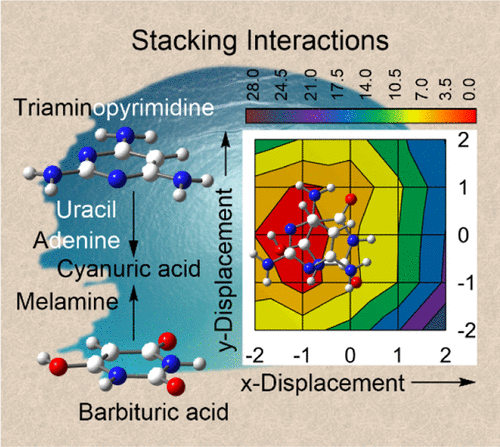当前位置:
X-MOL 学术
›
J. Chem. Inf. Model.
›
论文详情
Our official English website, www.x-mol.net, welcomes your
feedback! (Note: you will need to create a separate account there.)
Role of Stacking Interactions in the Stability of Primitive Genetics: A Quantum Chemical View
Journal of Chemical Information and Modeling ( IF 5.6 ) Pub Date : 2021-09-07 , DOI: 10.1021/acs.jcim.1c00276 Sarabjeet Kaur 1 , Payal Grover 2 , Stacey D Wetmore 3 , Purshotam Sharma 1
Journal of Chemical Information and Modeling ( IF 5.6 ) Pub Date : 2021-09-07 , DOI: 10.1021/acs.jcim.1c00276 Sarabjeet Kaur 1 , Payal Grover 2 , Stacey D Wetmore 3 , Purshotam Sharma 1
Affiliation

|
The origin of genetic material on earth is an age-old, entangled mystery that lacks a unanimous explanation. Recent studies have suggested that noncanonical bases such as barbituric acid (BA), melamine (MM), cyanuric acid (CA), and 2,4,6-triaminopyrimidine (TAP) may have undergone molecular selection within the “prebiotic soup” to spontaneously form supramolecular assemblies, which then covalently assembled into an RNA-like polymer (preRNA). However, information on the role of intrinsic interactions of these candidate heterocycles in their molecular selection as the components of preRNA, and the subsequent transition from preRNA to RNA, is currently missing in the literature. To fill this gap in our knowledge on the origin and evolution of primitive genetics, the present work employs density functional theory (B3LYP-D3) to evaluate and compare the stacking propensities of dimers containing prebiotic noncanonical (BA, MM, CA, and TAP) and/or canonical RNA bases (A, C, G, and U). Our detailed analysis of the variation in stacking strength with respect to four characteristic geometrical parameters between the monomers [i.e., the vertical distance, the angle of rotation, and (two) displacements in the x and y directions] reveals that stacking between nonidentical bases is preferred over identical bases for both prebiotic–prebiotic and canonical–canonical dimers. This not only underscores the similarity between the fundamental chemical properties of preRNA and RNA constituents but also supports the likelihood of the evolution of modern (RNA) genetics from primitive (preRNA) genetics. Furthermore, greater average stacking stabilization of canonical dimers than that of dimers containing one canonical and one preRNA nucleobase (by ∼5 kJ mol–1) or dimers solely containing preRNA nucleobases (by ∼12 kJ mol–1) indicates that enhanced stacking is an important factor that may have spurred the evolution of preRNA to an intermediate informational polymer to RNA. More importantly, our study identifies the central roles of CA, BA, and TAP in stacking stabilization within the preRNA and of BA in stacking interactions within the intermediate polymers and suggests that these heterocycles may have played distinct roles in various stages during the evolution from preRNA to RNA. Overall, our results highlight the significance of stacking interactions in the selection of nucleobase components of preRNA.
中文翻译:

叠加相互作用在原始遗传学稳定性中的作用:量子化学观点
地球上遗传物质的起源是一个古老而纠结的谜团,缺乏一致的解释。最近的研究表明,巴比妥酸 (BA)、三聚氰胺 (MM)、氰尿酸 (CA) 和 2,4,6-三氨基嘧啶 (TAP) 等非经典碱可能在“益生元汤”中经历了分子选择,从而自发地形成超分子组装体,然后共价组装成类 RNA 聚合物 (preRNA)。然而,目前文献中缺少关于这些候选杂环在它们作为 preRNA 组分的分子选择以及随后从 preRNA 到 RNA 的转变中的内在相互作用的作用的信息。为了填补我们关于原始遗传学起源和进化的知识空白,目前的工作采用密度泛函理论 (B3LYP-D3) 来评估和比较含有益生元非经典(BA、MM、CA 和 TAP)和/或经典 RNA 碱基(A、C、G 和 U)的二聚体的堆积倾向. 我们详细分析了单体之间四个特征几何参数的堆叠强度变化[即垂直距离、旋转角度和(两个)位移x和y方向]表明,对于益生元-益生元和规范-规范二聚体,不同碱基之间的堆叠优于相同碱基。这不仅强调了 preRNA 和 RNA 成分的基本化学性质之间的相似性,而且还支持现代 (RNA) 遗传学从原始 (preRNA) 遗传学进化的可能性。此外,规范二聚体的平均堆叠稳定性比包含一个规范和一个 preRNA 核碱基的二聚体(约 5 kJ mol –1)或仅包含 preRNA 核碱基的二聚体(约 12 kJ mol –1) 表明增强的堆叠是一个重要因素,可能刺激了 preRNA 进化为中间信息聚合物到 RNA。更重要的是,我们的研究确定了 CA、BA 和 TAP 在 preRNA 内堆积稳定性和 BA 在中间聚合物内堆积相互作用中的核心作用,并表明这些杂环可能在从 preRNA 进化的各个阶段发挥了不同的作用到 RNA。总的来说,我们的结果强调了叠加相互作用在选择 preRNA 的核碱基成分中的重要性。
更新日期:2021-09-27
中文翻译:

叠加相互作用在原始遗传学稳定性中的作用:量子化学观点
地球上遗传物质的起源是一个古老而纠结的谜团,缺乏一致的解释。最近的研究表明,巴比妥酸 (BA)、三聚氰胺 (MM)、氰尿酸 (CA) 和 2,4,6-三氨基嘧啶 (TAP) 等非经典碱可能在“益生元汤”中经历了分子选择,从而自发地形成超分子组装体,然后共价组装成类 RNA 聚合物 (preRNA)。然而,目前文献中缺少关于这些候选杂环在它们作为 preRNA 组分的分子选择以及随后从 preRNA 到 RNA 的转变中的内在相互作用的作用的信息。为了填补我们关于原始遗传学起源和进化的知识空白,目前的工作采用密度泛函理论 (B3LYP-D3) 来评估和比较含有益生元非经典(BA、MM、CA 和 TAP)和/或经典 RNA 碱基(A、C、G 和 U)的二聚体的堆积倾向. 我们详细分析了单体之间四个特征几何参数的堆叠强度变化[即垂直距离、旋转角度和(两个)位移x和y方向]表明,对于益生元-益生元和规范-规范二聚体,不同碱基之间的堆叠优于相同碱基。这不仅强调了 preRNA 和 RNA 成分的基本化学性质之间的相似性,而且还支持现代 (RNA) 遗传学从原始 (preRNA) 遗传学进化的可能性。此外,规范二聚体的平均堆叠稳定性比包含一个规范和一个 preRNA 核碱基的二聚体(约 5 kJ mol –1)或仅包含 preRNA 核碱基的二聚体(约 12 kJ mol –1) 表明增强的堆叠是一个重要因素,可能刺激了 preRNA 进化为中间信息聚合物到 RNA。更重要的是,我们的研究确定了 CA、BA 和 TAP 在 preRNA 内堆积稳定性和 BA 在中间聚合物内堆积相互作用中的核心作用,并表明这些杂环可能在从 preRNA 进化的各个阶段发挥了不同的作用到 RNA。总的来说,我们的结果强调了叠加相互作用在选择 preRNA 的核碱基成分中的重要性。











































 京公网安备 11010802027423号
京公网安备 11010802027423号